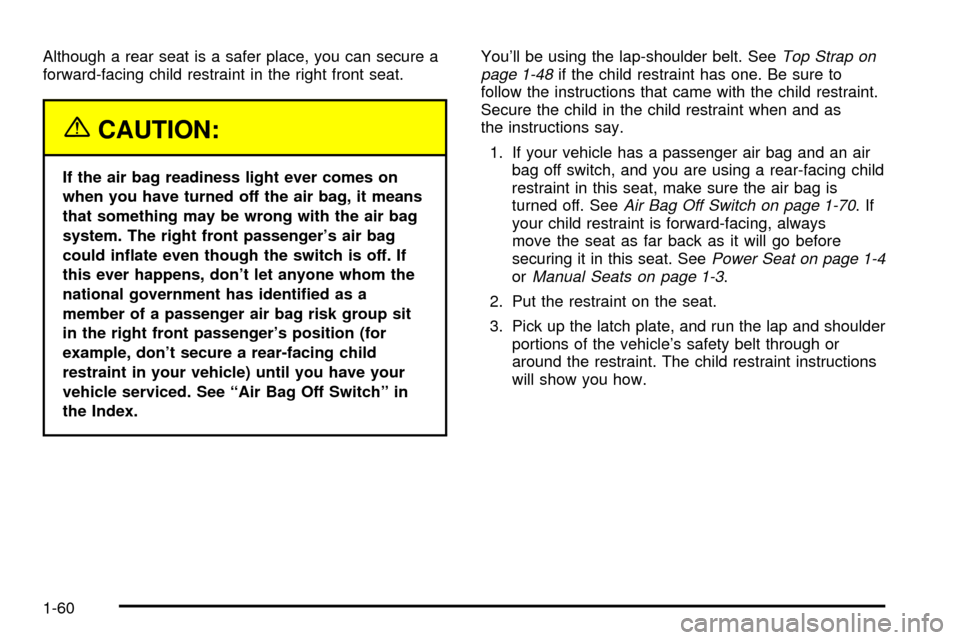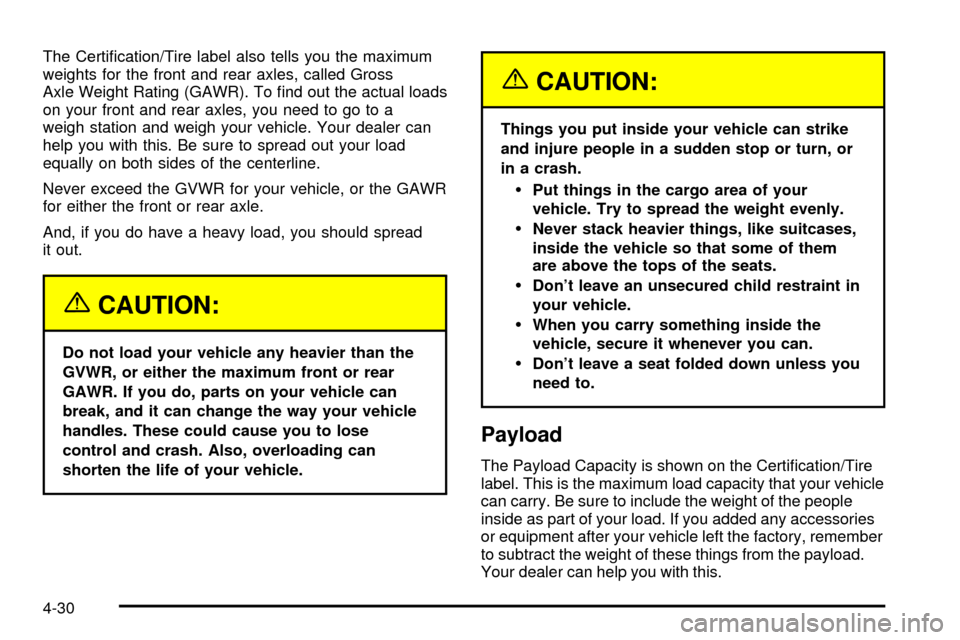2003 CHEVROLET EXPRESS CARGO VAN seats
[x] Cancel search: seatsPage 66 of 386

Although a rear seat is a safer place, you can secure a
forward-facing child restraint in the right front seat.
{CAUTION:
If the air bag readiness light ever comes on
when you have turned off the air bag, it means
that something may be wrong with the air bag
system. The right front passenger's air bag
could in¯ate even though the switch is off. If
this ever happens, don't let anyone whom the
national government has identi®ed as a
member of a passenger air bag risk group sit
in the right front passenger's position (for
example, don't secure a rear-facing child
restraint in your vehicle) until you have your
vehicle serviced. See ªAir Bag Off Switchº in
the Index.You'll be using the lap-shoulder belt. See
Top Strap on
page 1-48if the child restraint has one. Be sure to
follow the instructions that came with the child restraint.
Secure the child in the child restraint when and as
the instructions say.
1. If your vehicle has a passenger air bag and an air
bag off switch, and you are using a rear-facing child
restraint in this seat, make sure the air bag is
turned off. See
Air Bag Off Switch on page 1-70.If
your child restraint is forward-facing, always
move the seat as far back as it will go before
securing it in this seat. See
Power Seat on page 1-4orManual Seats on page 1-3.
2. Put the restraint on the seat.
3. Pick up the latch plate, and run the lap and shoulder
portions of the vehicle's safety belt through or
around the restraint. The child restraint instructions
will show you how.
1-60
Page 74 of 386

Seat Position Sensors
Vehicles with dual stage air bags are also equipped with
special sensors which enable the sensing system to
monitor the position of both the driver and passenger
front seats. The seat position sensors provide
information which is used to determine if the air bags
should deploy at a reduced level or at full depoyment.
Air Bag Systems
In any particular crash, no one can say whether an air
bag should have in¯ated simply because of the damage
to a vehicle or because of what the repair costs were.
In¯ation is determined by the angle of the impact
and how quickly the vehicle slows down in front or
near-frontal impacts.
What Makes an Air Bag In¯ate?
In an impact of sufficient severity, the air bag sensing
system detects that the vehicle is in a crash. The
sensing system triggers a release of gas from the
in¯ator, which in¯ates the air bag. The in¯ator, air bag,
and related hardware are all part of the air bag
modules inside the steering wheel and in the instrument
panel in front of the right front passenger.
How Does an Air Bag Restrain?
In moderate to severe frontal or near-frontal collisions,
even belted occupants can contact the steering wheel or
the instrument panel. Air bags supplement the
protection provided by safety belts. Air bags distribute
the force of the impact more evenly over the occupant's
upper body, stopping the occupant more gradually.
But air bags would not help you in many types of
collisions, including rollovers, rear impacts and many
side impacts, primarily because an occupant's motion is
not toward those air bags. Air bags should never be
regarded as anything more than a supplement to safety
belts, and then only in moderate to severe frontal or
near-frontal collisions.
What Will You See After an Air Bag
In¯ates?
After an air bag in¯ates, it quickly de¯ates, so quickly
that some people may not even realize the air bag
in¯ated. Some components of the air bag module ± the
steering wheel hub for the driver's air bag, or the
instrument panel for the right front passenger's
bag ± will be hot for a short time. The parts of the bag
that come into contact with you may be warm, but
not too hot to touch. There will be some smoke and dust
coming from the vents in the de¯ated air bags.
1-68
Page 140 of 386

Turn the center knob clockwise or counterclockwise
to change the direction of the air¯ow in the
rear-seating area.
To change the current mode, select one of the following:
D(Vent):Use this mode to direct air to the upper
outlets, with a little air directed to the ¯oor outlets.
2(Floor):Use this mode to direct most of the air to
the ¯oor outlets.
9(Fan):Turn the left knob clockwise or
counterclockwise to HIGH, MED (Medium) or LOW to
increase or decrease the fan speed in the rear-seating
area. Turn the knob to OFF to turn off the fan.
(Temperature Control):To increase or decrease the
temperature for the rear of the vehicle, turn the right
knob located on the climate-control panel.
The air-conditioning system on the main climate-control
panel must be turned on to direct cooled air to the
rear of the vehicle. If it is not on, then the temperature
in the rear of the vehicle will remain at cabin
temperature.
Be sure to keep the area under the front seats clear of
any objects so that the air inside of your vehicle can
circulate effectively.For information on how to use the main climate-control
system, see
Climate Control System on page 3-19listed previously in this section. For information
on ventilation, see ªOutlet Adjustmentº earlier in this
section.
Defogging and Defrosting
Fog on the inside of windows is a result of high humidity
(moisture) condensing on the cool window glass. This
can be minimized if the climate control is used properly.
There are two modes to clear fog or frost from your
windshield and side windows.
Use the defog mode to clear the windows of fog or
moisture and warm the passengers. Use the defrost
mode to remove fog or frost from the windshield more
quickly. For best results, clear all snow and ice from the
windshield before defrosting.
Turn the knob on the right of the climate control panel
to select the defog or defrost mode.
-(Blend):With this setting, the outside air comes out
of both the ¯oor and defroster outlets. Adjust the
temperature knob for warmer or cooler air. The air
conditioning compressor may operate in this setting to
dehumidify the air.
1(Defrost):This setting operates the defroster.
Most of the air comes out near the windshield, with
some going to the ¯oor outlets and front side windows.
3-22
Page 224 of 386

The Certi®cation/Tire label also tells you the maximum
weights for the front and rear axles, called Gross
Axle Weight Rating (GAWR). To ®nd out the actual loads
on your front and rear axles, you need to go to a
weigh station and weigh your vehicle. Your dealer can
help you with this. Be sure to spread out your load
equally on both sides of the centerline.
Never exceed the GVWR for your vehicle, or the GAWR
for either the front or rear axle.
And, if you do have a heavy load, you should spread
it out.
{CAUTION:
Do not load your vehicle any heavier than the
GVWR, or either the maximum front or rear
GAWR. If you do, parts on your vehicle can
break, and it can change the way your vehicle
handles. These could cause you to lose
control and crash. Also, overloading can
shorten the life of your vehicle.
{CAUTION:
Things you put inside your vehicle can strike
and injure people in a sudden stop or turn, or
in a crash.
·Put things in the cargo area of your
vehicle. Try to spread the weight evenly.
·Never stack heavier things, like suitcases,
inside the vehicle so that some of them
are above the tops of the seats.
·Don't leave an unsecured child restraint in
your vehicle.
·When you carry something inside the
vehicle, secure it whenever you can.
·Don't leave a seat folded down unless you
need to.
Payload
The Payload Capacity is shown on the Certi®cation/Tire
label. This is the maximum load capacity that your vehicle
can carry. Be sure to include the weight of the people
inside as part of your load. If you added any accessories
or equipment after your vehicle left the factory, remember
to subtract the weight of these things from the payload.
Your dealer can help you with this.
4-30
Page 379 of 386

Locks............................................................. 2-8
Cargo Door Relocking.................................... 2-8
Door........................................................... 2-7
Leaving Your Vehicle....................................2-10
Lockout Protection.......................................2-10
Power Door.................................................. 2-8
Rear Door Security Locks............................... 2-8
Loss of Control...............................................4-12
Low Coolant Warning Light..............................3-33
M
Maintenance, Normal Replacement Parts..........5-100
Maintenance Schedule.....................................6-11
At Each Fuel Fill.........................................6-11
At Least Once a Month................................6-11
At Least Once a Year..................................6-13
At Least Twice a Year..................................6-12
At the First 100, 1,000 and 6,000 Miles
(160, 1 600 and 10 000km).......................6-11
Brake System Inspection..............................6-17
Engine Cooling System Inspection.................6-16
Exhaust System Inspection...........................6-16
Fuel System Inspection................................6-16
How This Section is Organized....................... 6-3
Introduction.................................................. 6-2
Maintenance Requirements............................. 6-2
Part A - Scheduled Maintenance Services......... 6-4Maintenance Schedule (cont.)
Part B - Owner Checks and Services.............6-11
Part C - Periodic MaintenanceInspections......6-16
Part D - Recommended Fluids and
Lubricants...............................................6-18
Part E - Maintenance Record........................6-20
Rear Axle Service........................................6-17
Scheduled Maintenance................................. 6-5
Steering and Suspension Inspection...............6-16
Throttle System Inspection............................6-17
Transfer Case and Front Axle
(All-Wheel Drive) Inspection.......................6-17
Using Your................................................... 6-4
Your Vehicle and the Environment................... 6-2
Maintenance When Trailer Towing.....................4-43
Making Turns.................................................4-42
Malfunction Indicator Light................................3-33
Manual Seats................................................... 1-3
Manual Windows............................................2-16
Matching Transmitter(s) to Your Vehicle............... 2-5
Mexico, Central America and Caribbean Islands/
Countries (Except Puerto Rico and
U.S. Virgin Islands) ± Customer Assistance....... 7-4
Mirrors..........................................................2-31
Manual Rearview Mirror................................2-31
Outside Camper-Type Mirrors........................2-32
Outside Convex Mirror.................................2-34
Outside Heated Mirrors................................2-34
9
Page 382 of 386

Rear Door Security Locks.................................. 2-8
Rear Doors....................................................2-14
Rear Heating System......................................3-20
Rear Safety Belt Comfort Guides......................1-31
Rear Seat Audio (RSA)....................................3-71
Rear Seat Operation......................................... 1-6
Rear Seat Outside Passenger Positions.............1-28
Rear Seat Passengers, Safety Belts..................1-28
Rear Seat Radio Controls................................3-71
Rear Window Defogger....................................3-23
Rearview Mirrors.............................................2-31
Reclining Seatbacks.......................................... 1-4
Recreational Vehicle Towing.............................4-29
Remote Keyless Entry System, Operation............ 2-4
Remote Keyless Entry System............................ 2-3
Removing the Flat Tire and Installing the
Spare Tire..................................................5-72
Removing the Rear Seat................................... 1-6
Removing the Spare Tire and Tools...................5-66
Removing the Wheel Covers............................5-72
Replacement Bulbs.........................................5-54
Replacing Brake System Parts..........................5-40
Replacing Restraint System Parts After
a Crash.....................................................1-75
Replacing the Rear Seats.................................. 1-8
Reporting Safety Defects................................... 7-9
Canadian Government................................... 7-9
General Motors............................................. 7-9
United States Government.............................. 7-8Restraint System Check...................................6-12
Checking Your Restraint Systems...................1-74
Replacing Restraint System Parts After
a Crash..................................................1-75
Restraint Systems...........................................1-74
Checking....................................................1-74
Replacing Parts...........................................1-75
Resynchronization............................................. 2-5
Retained Accessory Power (RAP)......................2-21
Right Front Passenger Position, Safety Belts......1-25
Roadside......................................................... 7-5
Assistance Program....................................... 7-5
Rocking Your Vehicle To Get It Out...................4-28
Running Your Engine While You Are Parked.......2-30
S
Safety Belt.....................................................3-26
Reminder Light............................................3-26
Safety Belts...................................................5-83
Care of......................................................5-83
Center Passenger Position....................1-25, 1-26
Driver Position............................................1-16
How to Wear Safety Belts Properly................1-15
Questions and Answers About Safety Belts.....1-14
Rear Safety Belt Comfort Guides for Children
and Small Adults......................................1-31
Rear Seat Passengers.................................1-28
Right Front Passenger Position......................1-25
12
Page 383 of 386

Safety Belts (cont.)
Safety Belt Extender....................................1-33
Safety Belt Use During Pregnancy.................1-24
Safety Belts Are for Everyone.......................1-10
Safety Chains.................................................4-40
Safety Warnings and Symbols.............................. iii
Scheduled Maintenance..................................... 6-5
Seats.............................................................. 1-3
Manual........................................................ 1-3
Power Seat.................................................. 1-4
Rear Seat Operation...................................... 1-6
Reclining Seatbacks...................................... 1-4
Secondary Latch System.................................5-69
Securing a Child Restraint................................1-56
Center Seat Position....................................1-56
Designed for the LATCH System...................1-53
Rear Outside Seat Position...........................1-53
Right Front Seat Position..............................1-58
Security Light.................................................3-37
Service Bulletins.............................................7-10
Service Manuals............................................... 7-9
Service........................................................... 5-3
Adding Equipment to the Outside of Your
Vehicle..................................................... 5-4
Doing Your Own Work................................... 5-3
Engine Soon Light.......................................3-33
Publications Ordering Information..................... 7-9
Servicing Your Air Bag-Equipped Vehicle............1-73
Setting Preset PTYs................................3-52, 3-64
Setting Preset Stations............3-42, 3-45, 3-50, 3-61Setting the Time.............................................3-41
Radios with Radio Data Systems (RDS).........3-41
Radios without Radio Data Systems (RDS).....3-40
Setting the Tone (Bass/Treble).................3-42, 3-45,
3-50, 3-61
Sheet Metal Damage.......................................5-86
Shifting Into Park (P).......................................2-26
Shifting Out of Park (P)...................................2-29
Shoulder Belt Height Adjuster...........................1-18
Single Stage Air Bags.....................................1-67
Skidding........................................................4-12
Sliding Side Door............................................2-11
Some Other Rainy Weather Tips.......................4-17
Spare Tire Check............................................6-12
Special Fabric Cleaning Problems.....................5-81
Speci®cations, Capacities.................................5-97
Speedometer..................................................3-25
Starter Switch Check.......................................6-13
Starting Your Engine.......................................2-22
Steering and Suspension Inspection..................6-16
Steering in Emergencies.................................... 4-9
Steering Tips................................................... 4-8
Steering.......................................................... 4-8
Storage Areas................................................2-36
Storing a Flat or Spare Tire and Tools...............5-78
Stuck in Sand, Mud, Ice or Snow......................4-28
Sun Visors.....................................................2-19
Swing-Out Side Door, 60/40.............................2-13
Swing-Out Windows........................................2-18
13